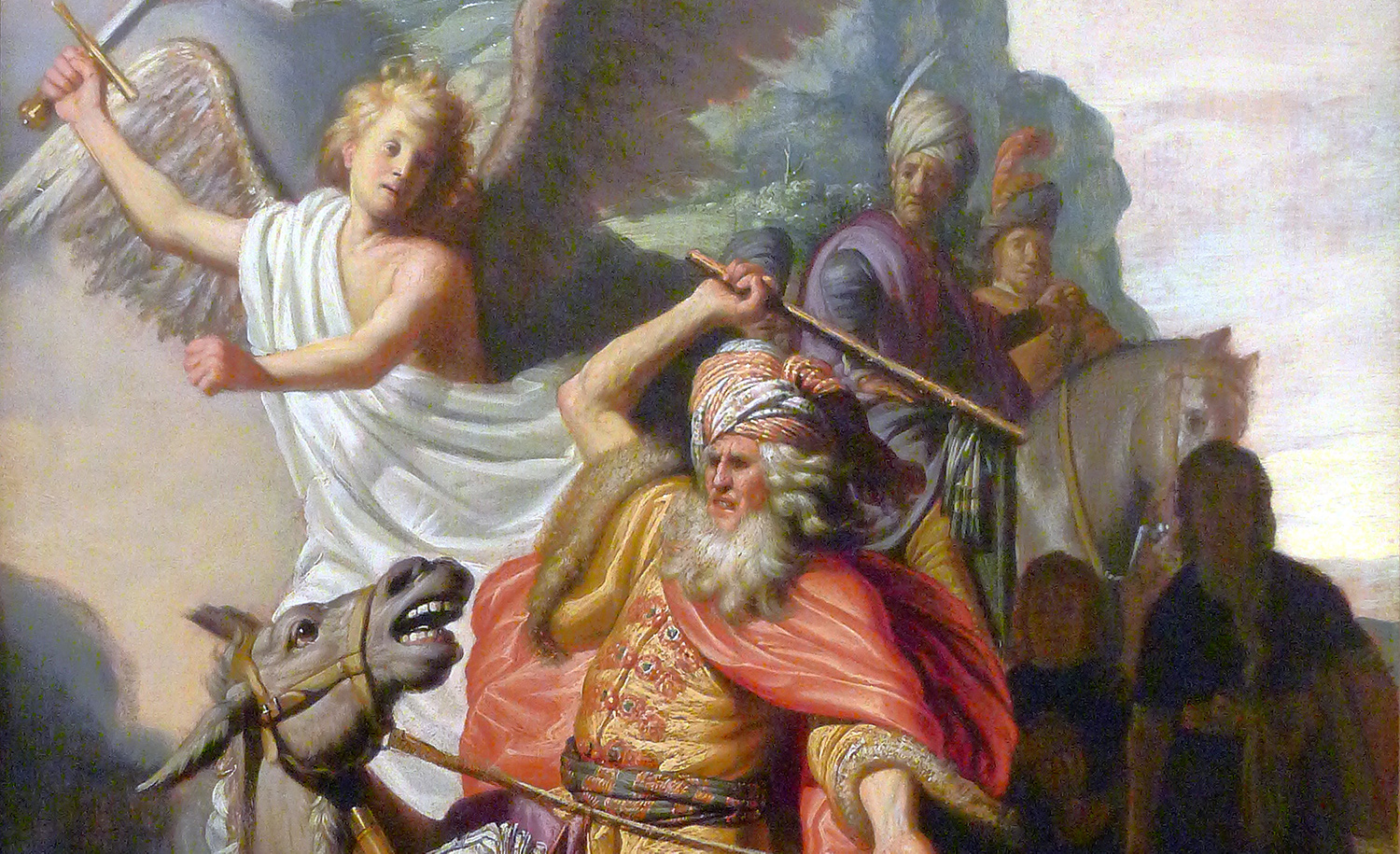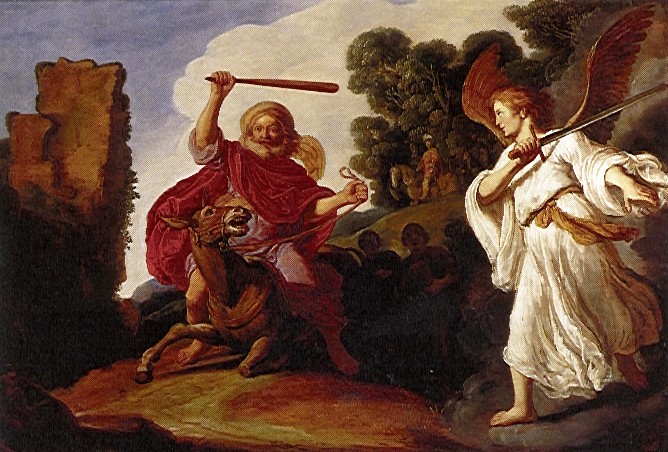This is the fourth in an occasional series of essays by Rabbi Meir Soloveichik on the intersection of Jews and Judaism with the artistic practice, and the aesthetic vision, of the great 17th-century Dutch master Rembrandt van Rijn. To see the earlier installments, click here.
In 1625, a nineteen-year-old aspiring artist journeyed from Leiden to Amsterdam where he apprenticed himself to Pieter Lastman, the premier Dutch painter of his time. Lastman was known as a “history painter”—the history being primarily biblical—and the young man, whose name was Rembrandt van Rijn, aspired to follow in Lastman’s footsteps.
Immediately following his six-month apprenticeship to Lastman, who surely had no idea that he would one day be entirely eclipsed by his student, Rembrandt created a work known today as Balaam and the Ass. It presents Rembrandt’s version of the famous tale that is the centerpiece of this week’s Torah reading from the book of Numbers (22:2-25:9). On a potentially lucrative mission to pronounce curses upon the people of Israel, Balaam, a Gentile prophet hired by Balak, the king of the Moabites, is brought up short by his unusually eloquent animal:
Now [Balaam] was riding upon his ass, and his two servants were with him. And the ass saw the angel of the Lord standing in the way, with his sword drawn in his hand; and the ass turned aside out of the way, and went into the field; and Balaam smote the ass, to turn her into the way. . . . And the Lord opened the mouth of the ass, and she said unto Balaam: “What have I done unto thee, that thou hast smitten me these three times?” And Balaam said unto the ass: “Because thou hast mocked me; would there were a sword in my hand, for now I had killed thee.” Then the Lord opened the eyes of Balaam, and he saw the angel of the Lord standing in the way, with his sword drawn in his hand; and he bowed his head, and fell on his face.
By the end of the tale, through a series of further convolutions, Balaam’s projected curses on Israel will have been transformed into ecstatic blessings.
Today Balaam and the Ass hangs in Paris’s Musée Cognacq-Jay. On a visit to the museum, I was struck at first by certain obvious differences between this youthful effort and the biblical scenes that Rembrandt would later bring so unforgettably to life. Understandably enough, the style is very similar to that of Lastman’s rendering of the same scene, with little hint of the pictorial power and fidelity to his subject that would soon be displayed in Rembrandt’s Jeremiah, let alone his later paintings of Jacob and Moses.
In this connection, I could not help noticing a minor but telling detail: the man who would later pay uncannily close attention to Hebrew lettering and create exquisitely formed Hebrew words—see Belshazzar’s Feast, for example—has here covered with illegible scrawls the visible portions of the papers stuffed into Balaam’s satchel. Squinting to discover some semblance of Hebrew, I studied the evidence in vain.
And yet, despite these signs of unfledged beginnings, other signs emerge as well—preeminently, Rembrandt’s sheer genius at grasping and communicating the inner meanings of biblical texts. In this respect, especially when it comes to the depiction of Balaam himself, his youthful painting of the recognition scene on the road could not offer a greater contrast to Lastman’s.
In Lastman, the prophet is clearly in a state of shock at being addressed by an animal, and his eyes bug out cartoonishly. But, as Simon Schama notes, Rembrandt, in what may well have been a deliberate move to differentiate himself from his master, goes in the opposite direction, giving us two darkened crevices where the prophet’s eyes should be. Revealed by the veil of darkness over Balaam’s vision is thus not shock or astonishment at the donkey’s verbal ability but rather the prophet’s inability to see the angel of the Lord who is standing before him.
For Rembrandt, in other words, the biblical tale best known for its talking animal is not really about speech at all. And indeed the text explicitly informs us that Balaam, showing no sign of surprise, responds naturally and angrily to his uppity steed, for no prophet accustomed to greater miracles than this would be shocked by such a phenomenon. Rather, what is truly astonishing is that a prophet of God could fail to see what even his donkey could see: an ethereal angel standing right in front of his face.
Once confronted by the angel, Balaam himself concedes this failing:
And the angel of the Lord said unto him: “Wherefore hast thou smitten thine ass these three times? Behold, I am come forth for an adversary, because thy way is contrary unto me; and the ass saw me, and turned aside before me these three times; unless she had turned aside from me, surely now I had even slain thee, and saved her alive.” And Balaam said unto the angel of the Lord: “I have sinned; for I knew not that thou stoodest in the way against me; now therefore, if it displease thee, I will get me back.”
Rembrandt’s insight into the nature of Balaam’s sin takes us back to an earlier moment in this story, whose contours are among the most perplexing in the Bible. When the Moabite king hires Balaam to curse Israel, God’s first response is to enjoin Balaam from proceeding: “Thou shalt not go with them; thou shalt not curse that people; for they are blessed.” Balaam, obeying, then informs the Moabites that he is declining the assignment: even “if Balak would give me his house full of silver and gold, I cannot go beyond the word of the Lord my God, to do any thing, small or great.”
But suddenly God seems to permit Balaam to accept the assignment after all, on the condition that he speak only as expressly commanded by God. When, however, the prophet once again obeys, the Lord is once again incensed, dispatching the angel to confront him on the road:
And God came unto Balaam at night, and said unto him: “If the men are come to call thee, rise up, go with them; but only the word which I speak unto thee, that shalt thou do.” And Balaam rose up in the morning, and saddled his ass, and went with the princes of Moab. And God’s anger was kindled because he went; and the angel of the Lord placed himself in the way for an adversary against him.
If Balaam has been expressly allowed to journey, why is the Almighty upset? Rembrandt’s painting may help us intuit the answer. Balaam’s sin is internal, having to do with the reason he has joined the Moabites and accepted Balak’s assignment to begin with. He is untroubled—on the contrary, he’s excited—by being chosen to serve as Balak’s prophet-for-hire. Having transgressed his duty to focus on the will of God, he is hellbent instead on cursing God’s beloved Israel for pecuniary gain.
Indeed, in the confirming summation of Israelite history in the book of Deuteronomy, we learn that Balaam was hoping for the opportunity to curse Israel, that the blessings he would finally bestow upon the Israelites ran against his inner intentions, and that only divine intervention confounded his plan: “But the Lord thy God would not hearken to Balaam; but the Lord thy God turned the curse into a blessing unto thee, because the Lord thy God loved thee.” (23:5)
How, then, does Rembrandt convey the prophet’s interest in profit? How can we know that Balaam has proceeded utterly untroubled by the fact that he has been hired to curse the people that God has already blessed? We know it from the fact that he plunges ahead, blind to the reality, which even a simple animal can sense, that an angel of God is standing right in front of him. Balaam’s eyes are shadowy crevices because, at this moment, he really is blind. As Simon Schama writes, Rembrandt here is giving us “the moment before God opens those eyes to the angel and the light of truth.”
Balaam is the one Gentile prophet known to us in the Tanakh, and the sages insist that his presence in Hebrew scripture is important. He is a reminder that God’s manifestation is made known not only to Israel but also among the nations of the world; spiritual intuition is present everywhere. The artist who millennia later would bring Balaam’s story to life was not himself a prophet; but by his insights into the texts of the Hebrew Bible he deserves to be known as one of the greatest seers among the nations.
More about: Arts & Culture, History & Ideas, Rembrandt and the Jews








